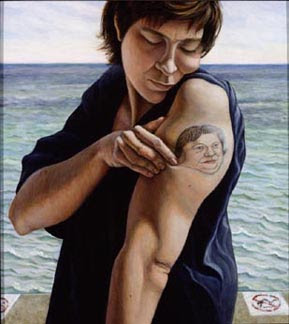MANIFESTO OF CARNAL ART
by ORLAN
DEFINITION
Carnal Art is self-portraiture in the classical sense, but realised through the possibility of technology. It swings between defiguration and refiguration. Its inscription in the flesh is a function of our age. The body has become a “modified ready-made”, no longer seen as the ideal it once represented ;the body is not anymore this ideal ready-made it was satisfaying to sign.
DISTINCTION
As distinct from “Body Art”, Carnal Art does not conceive of pain as
redemptive or as a source of purification. Carnal Art is not interested in the plastic-surgery result, but in the process of surgery, the spectacle and discourse of the modified body which has become the place of a public debate.
ATHEISM
Carnal Art does not inherit the Christian Tradition, it resists it! Carnal Art illuminates the Christian denial of body-pleasure and exposes its weakness in the face of scientific discovery. Carnal Art repudiates the tradition of suffering and martyrdom, replacing rather than removing, enhancing rather than diminishing - Carnal Art is not self-mutilation.
Carnal Art transforms the body into language, reversing the biblical idea of the word made flesh ; the flesh is made word. Only the voice of Orlan remains unchanged. The artist works on representation.
Carnal Art finds the acceptance of the agony of childbirth to be
anachronistic and ridiculous. Like Artaud, it rejects the mercy of God -Henceforth we shall have epidurals, local anaesthetics and multiple analgesics ! (Hurray for the morphine !) Vive la morphine ! (down with the pain !) A bas la douleur !
PERCEPTION
I can observe my own body cut open without suffering !....I can see myself all the way down to my viscera, a new stage of gaze. “I can see to the heart of my lover and it's splendid design has nothing to do with symbolics mannered usually drawn.
Darling, I love your spleen, I love your liver, I adore your pancreas and the line of your femur excites me.
FREEDOM
Carnal Art asserts the individual independence of the artist. In that sense it resists givens and dictats. This is why it has engaged the social, the media, (where it disrupts received ideas and cause scandal), and will even reached as far as the judiciary (to change the Orlan's name).
CLARIFICATION
Carnal Art is not against aesthetic surgery, but against the standards that pervade it, particularly, in relation to the female body, but also to the male body. Carnal Art must be feminist, it is necessary. Carnal Art is not only engages in aesthetic surgery, but also in developments in medicine and biology questioning the status of the body and posing ethical problems.
STYLE
Carnal Art loves parody and the baroque, the grotesque and the extreme.
Carnal Art opposes the conventions that exercise constraint on the human body and the work of art.
Carnal Art is anti-formalist and anti-conformist.






































